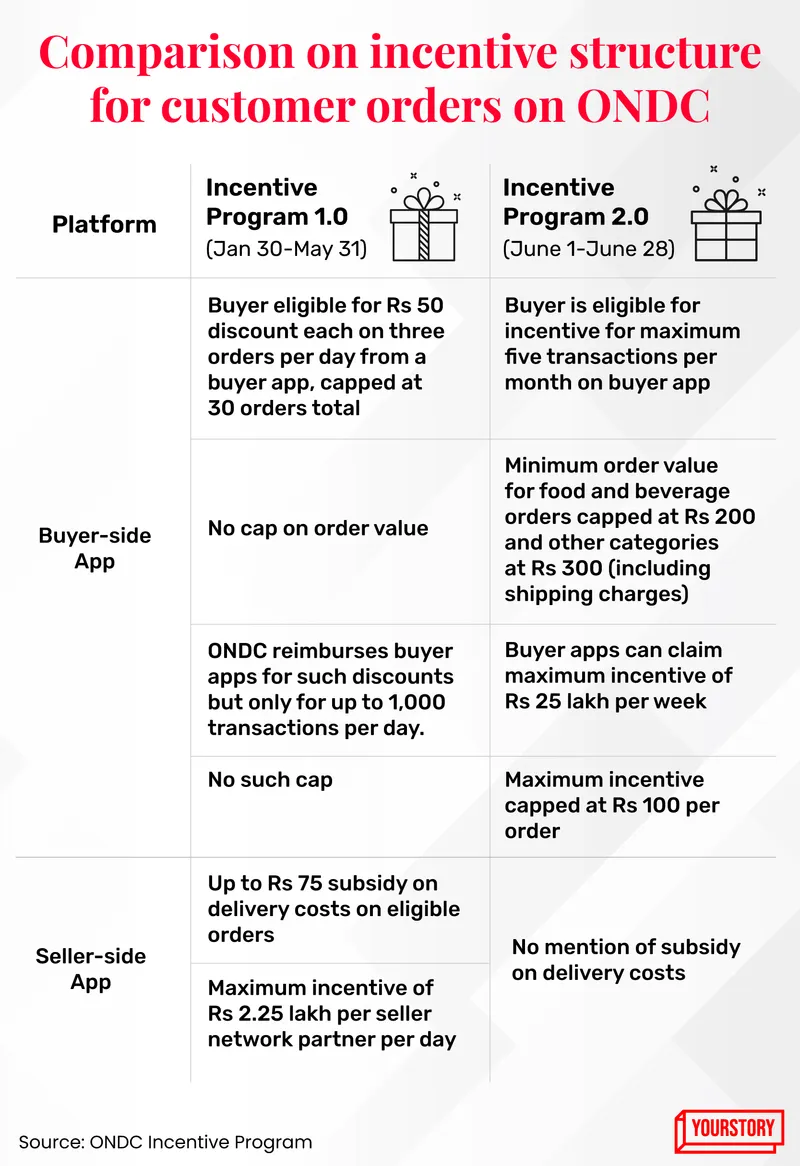ONDC revises incentive structure, slashes discounts
Buyers and sellers still stand to benefit, say ONDC participants, as the ecommerce network protocol phases down its first round of incentives to introduce more measured and inclusive discounts beginning next month.
Key Takeaways
ONDC to roll out second phase of incentives from June 1, hoping to reduce dependency on discounts for customer acquisition.
Buyers and sellers still expected to benefit from other inherent aspects of unbundled ecommerce, say network participants.
The counter-market approach comes even as daily orders on ONDC remain a fraction of that on other ecommerce platforms.
As with any discounts, ONDC’s much-hyped incentives—steeper than those on Swiggy and Zomato—are quickly proving to be transient.
The government-backed announced a revamped incentive programme Tuesday, ending the first phase of its discounting schemes effective May 31. YourStory has seen a copy of the notification issued to ONDC's network partners.
While the discounts helped ONDC scale to a peak 25,000 orders on May 11—still only a fraction of the daily orders on other ecommerce platforms—the network has decided to transition to a more measured approach beginning June 1, according to multiple people who are a part of the network.
ONDC Chief Business Officer Shireesh Joshi confirmed the broader plan for the second phase of the network’s incentive programme, without going into the specifics.
“The primary purpose (of the incentives) was for people to understand that unbundled commerce works. It was never about the price,” Joshi said in an exclusive interaction with YourStory. “At no point do we expect the floodgates to open for incentives–not now, not ever.”
Now that customers are familiar with ordering on ONDC, the network is working towards capping the extent of the incentives, Joshi added.
“We will maintain some stimulus, while at the same time, we don’t want to make it the reason for business to happen,” he said.
ONDC’s decision to moderate its incentives programme follows shortly after Commerce and Industry Minister Piyush Goyal made it clear that the government was not in favour of incentivising orders placed on the network to compete with other consumer internet apps.
Goyal was addressing an event in Bengaluru on May 22 to commemorate the completion of one year of ONDC, with more than 80 members of the network participating.
Following the peak of 25,000 orders on May 11, the network currently handles a weekly average of 13,000 orders in retail—mostly food and grocery—and over 36,000 rides, as announced at the event, ONDC Elevate.
Swiggy and Zomato handle about 1.5 million orders every day.
Incentive Program 2.0
As part of ONDC's Incentive Program 2.0, which comes into effect on June 1, the network will offer two kinds of incentives—one for seller network participants for onboarding quality sellers, and the other for boosting transactions to be rolled out through buyer network participants.
It's the latter that will significantly dent discounts for buyers purchasing on ONDC platforms.
Buyer-side apps such as Paytm and Phonepe-backed Pincode will now be able to tweak the incentives based on time of the day, day of the week, and other levers.
Also, ONDC has capped the minimum order value to Rs 200 for food and beverages, and Rs 300 for all other categories, including shipping charges. This was missing in the previous incentive structure.
But among the most significant changes is a cap on the maximum incentive per order to Rs 100—a clear departure from the earlier structure that allowed potential discounts of up to Rs 125 per order.
This earlier scheme was as per the first phase of the incentive programme that had come into effect on March 7 as an amendment to the initial January 30 notification.
Another huge rollback on discounts is that a buyer will now be eligible for incentives only on a maximum of five orders per month. This is in sharp contrast to the previous incentive structure, under which a buyer could avail of a discount of Rs 50 on each of three orders per day on any ONDC buyer app.
Under the previous programme, ONDC had also allowed seller apps to offer free delivery of up to Rs 75 that they could later get reimbursed. The new scheme does not mention any incentive to facilitate free deliveries by seller apps.
The discount on delivery charges will now likely have to be claimed by buyer-side apps as part of the Rs 100 maximum discount per order.

Comparison of new and old incentive programs
ONDC’s decision to temper these incentives is expected to naturally lead to a reduction in orders, particularly from bargain-hunters.
“Incentives were given for people to experience (ONDC). The new plan will restrict users from using incentives multiple times in the same day,” said Brij Purohit, Co-founder at SellerApp, a seller network partner that onboards sellers on ONDC.
Platforms unruffled
Network participants YourStory spoke with seemed unperturbed by the possibility of the reduced incentives taking away business, considering other cost benefits.
“Everything being equal, we are saving on three aspects–delivery cost, platform commissions, and discounts,” said Anurag Katriar, Founder and Managing Director of Indigo Hospitality and former president of the National Restaurant Association of India, which has been taking on food-delivery platforms Swiggy and Zomato over multiple issues.
“These three add up to nearly 40% of the revenue for any restaurant. Even if you have to bear the cost of logistics on ONDC, restaurants can pass on the savings,” he said.
Katriar added that by being a part of ONDC, restaurants can choose to push discounts during slow months rather than having to offer discounts all-year round on food-aggregation platforms.
Anshoo Sharma, Co-founder and CEO of Zomato-backed hyperlocal startup , said any market needs some incentivisation for behaviour-forming.
“Over a period as more alternatives emerge for merchants–say from two large apps to 12 large apps–their cost of reaching customers goes down. For that to happen, the network will have to be at scale,” he said.
Magicpin, a seller network that joined ONDC in March with 22,000 restaurant partners, recorded 20,000 orders a day for ONDC on May 11.
Apart from incentivisation by ONDC itself, discounts are also offered at the platform level.
Paytm is said to be in discussions to stop charging commissions from ONDC buyer apps. Seller network partner MyStore Co-founder Kriti Aggarwal told YourStory that the app was working with SIDBI on an employee incentive programme.
“We are running a voucher programme for SIDBI on our buyer side app where 1,500 employees can avail vouchers of Rs 10,000 each to buy from SIDBI sellers on ONDC on-boarded by Mystore,” Aggarwal told YourStory. “Employees can purchase from weavers, artisans, and small enterprises, and this programme benefits both sellers and the employees.”
ONDC’s second phase of incentives, with its controlled discounting, however, could make it difficult to expand the network. Joshi, though, is optimistic about other intrinsic factors weighing in.
“There is the magic of the word ‘free’. If you say ‘free deliveries’, it is different from 20-30% off,” Joshi said. “The point is now that we know unbundled commerce works, we are trying to see how to maintain some degree of stimulus that encourages people to try without having to go to the extent of current incentives.”
(Cover image and infographics by Winona Laisram)
Edited by Feroze Jamal








